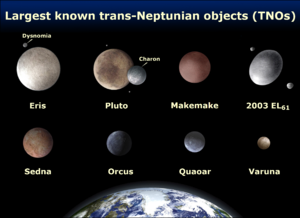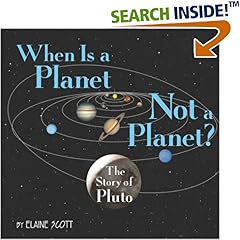 Not quite a planet, not quite an asteroid, an underdeveloped planetary tweener. In 2005, scientists began naming like minded spherical satellites, Dwarf Planets. Just last month, dwarf planets evolved as a classification with an announcement of the sub-class, Plutoid. The plutoid has to be really bright to get on the list. July 11, 2008, the IAU conferred plutoid status on Makemake due to its surpassing the absolute magnitude threshold.
Not quite a planet, not quite an asteroid, an underdeveloped planetary tweener. In 2005, scientists began naming like minded spherical satellites, Dwarf Planets. Just last month, dwarf planets evolved as a classification with an announcement of the sub-class, Plutoid. The plutoid has to be really bright to get on the list. July 11, 2008, the IAU conferred plutoid status on Makemake due to its surpassing the absolute magnitude threshold.Now space scientists says the pockmarked Putoids have friends. They are a team of three, almost a 1/3 of the number of "real" planets. From out in the Kuiper Belt, MakeMake, the latest discovery looks like a girl's mauve bowling ball with only one finger hole. It's named after a Polynesian Fertility being, so maybe more are on the way. Being scientists there is a distinct difference between being a dwarf planet and a Plutoid. There is a PhD in lost in space to be discovered in there somewhere.
The smallest of the plutoids, Makemake was discovered in March 2005 by a
team of scientists led by Michael Brown, from the California
Institute of Technology, and it was first named 2005 FY9 (unofficially known as
Easterbunny). The name Makemake was chosen later on by Michael Brown himself,
after the god of fertility from the Island of Rapa Nui (or the Easter Island).We consider the naming of objects in the Solar System carefully. Makemake's surface is covered with large amounts of almost pure methane ice, which is scientifically fascinating, but really not easily relatable to terrestrial mythology,” Brown explained. However, the Island Rapa Nui came to mind, and a brief search through mythology brought Makemake to light. Image credit: Ann Feild (Space Telescope Science Institute)
 The last full planet stop in this solar system is Neptune. That Easter Island came to ruin is somewhat Ironic. Far off the coast of Peru and Chile, Rapa Nui or as the European called it Easter Island, is now a UNESCO World Heritage Site. According to lore, MakeMake created humankind and was the chief god for the birders - before the island was denuded of trees resembling a plutoid. Don't think the Plutoids or Dwarf planets have a shot at the earthly UN designation. However it dows get to be a proud TNO or trans-Netunian Object that is brighter than bretheren like .
The last full planet stop in this solar system is Neptune. That Easter Island came to ruin is somewhat Ironic. Far off the coast of Peru and Chile, Rapa Nui or as the European called it Easter Island, is now a UNESCO World Heritage Site. According to lore, MakeMake created humankind and was the chief god for the birders - before the island was denuded of trees resembling a plutoid. Don't think the Plutoids or Dwarf planets have a shot at the earthly UN designation. However it dows get to be a proud TNO or trans-Netunian Object that is brighter than bretheren like .
Take Pity on me and Pluto. Purchase the book, When is a Planet Not A Planet: The Story of Pluto. Elaine Scott explains the dwarf planet nomenclature for the pint sized among us. Those large will find the full story on Pluto and the solar system quite interesting.










No comments:
Post a Comment